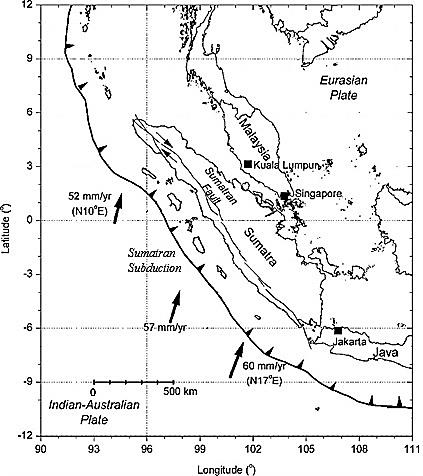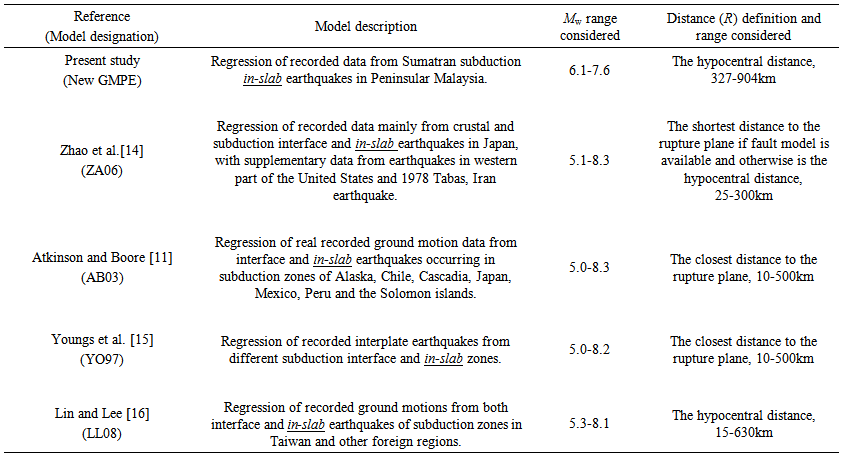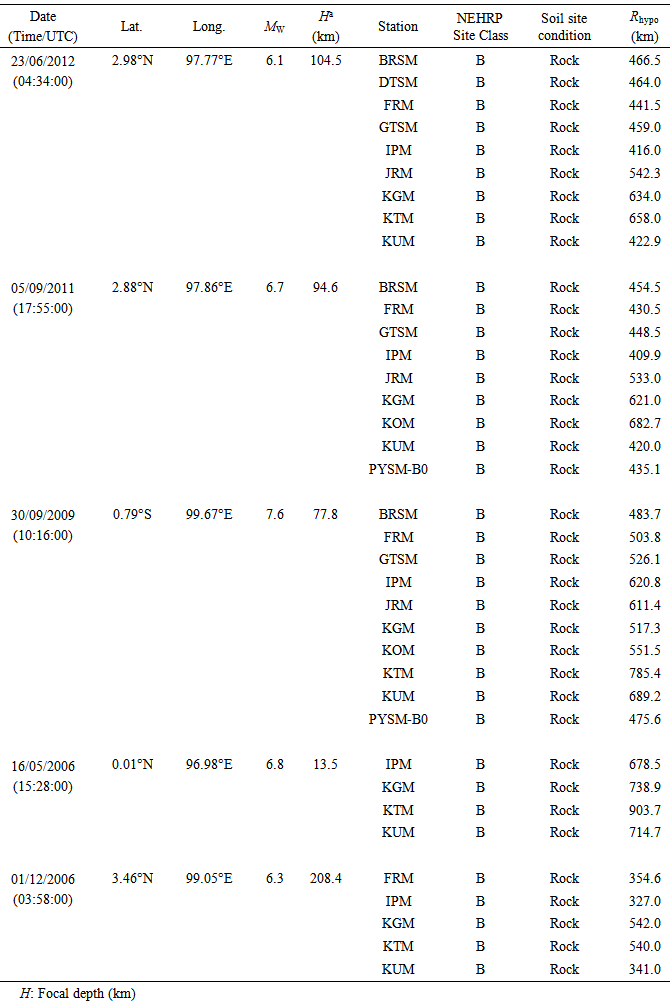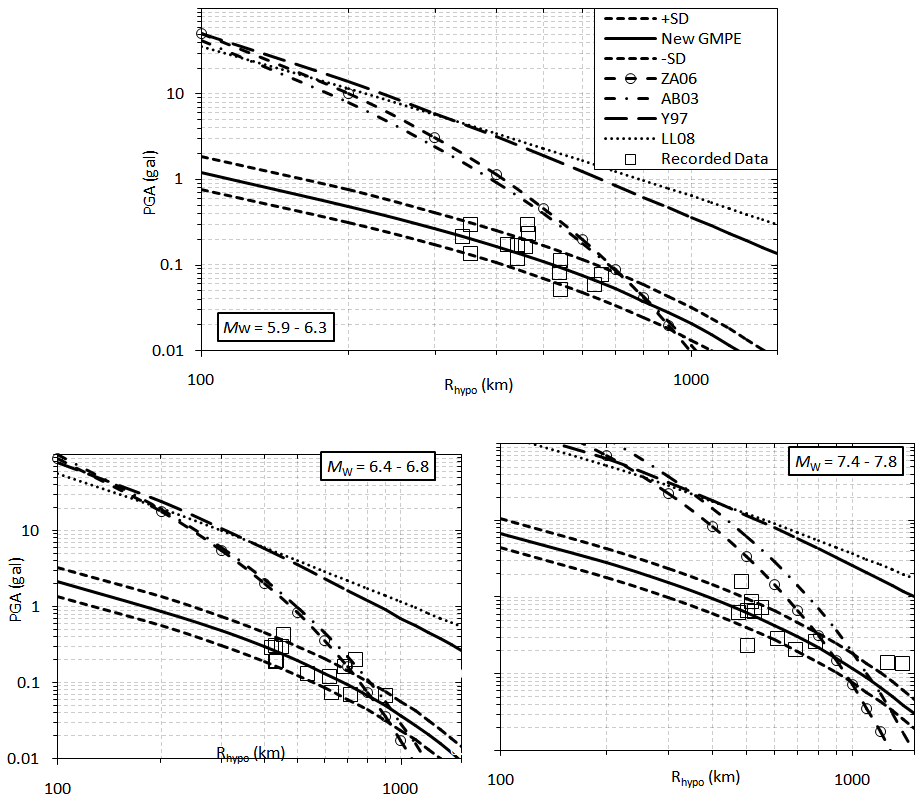-
Paper Information
- Next Paper
- Previous Paper
- Paper Submission
-
Journal Information
- About This Journal
- Editorial Board
- Current Issue
- Archive
- Author Guidelines
- Contact Us
Journal of Civil Engineering Research
p-ISSN: 2163-2316 e-ISSN: 2163-2340
2014; 4(3A): 124-129
doi:10.5923/c.jce.201402.21
On the Selection of Ground-Motion Prediction Equations Compatible with Peninsular Malaysia Region for Sumatran Subduction In-Slab Earthquakes
Azlan Bin Adnan1, Abdollah Vaez Shoushtari1, Noor Sheena Herayani Binti Harith1, 2
1Faculty of Civil Engineering, Universiti Teknologi Malaysia, Johor Bahru, Malaysia
2School of Engineering and Information Technology, Universiti Malaysia Sabah, Kota Kinabalu, Malaysia
Correspondence to: Azlan Bin Adnan, Faculty of Civil Engineering, Universiti Teknologi Malaysia, Johor Bahru, Malaysia.
| Email: |  |
Copyright © 2014 Scientific & Academic Publishing. All Rights Reserved.
Although Peninsular Malaysia is located in a low-seismicity region, the medium to high rise structures could be vulnerable to distant earthquakes generated by Sumatran fault and Sumatran subduction seismic sources. In addition, seismic design has not been specifically considered in the building design codes of the region. Therefore, it is rational to assess the seismic hazard of the region to apply appropriate seismic designs for the existing and future structures. The most comprehensive method recommended by design codes is Probabilistic method in order to do Seismic Hazard Analysis (i.e. called PSHA). The key component required in any seismic hazard analysis is employing an appropriated set of Ground-Motion Prediction Equations (GMPEs). This paper has attempted firstly to drive new GMPE for Peak Ground Acceleration (PGA) using data recorded in Peninsular Malaysia due to Sumatran subduction in-slab earthquakes. Secondly, the study has presenteda classification among the new derived GMPE and other four GMPEs proposed for subduction in-slab earthquakes of different regions through a comparative study based on the PGAs recorded in Peninsular Malaysia. The goal of the classification was to introduce the GMPEs which were the most compatible with the region. The results of the present study are applicable for seismic hazard analysis in Peninsular Malaysia.
Keywords: Ground-motion prediction equation, Sumatran subduction in-slab earthquake, Peninsular malaysia
Cite this paper: Azlan Bin Adnan, Abdollah Vaez Shoushtari, Noor Sheena Herayani Binti Harith, On the Selection of Ground-Motion Prediction Equations Compatible with Peninsular Malaysia Region for Sumatran Subduction In-Slab Earthquakes, Journal of Civil Engineering Research, Vol. 4 No. 3A, 2014, pp. 124-129. doi: 10.5923/c.jce.201402.21.
Article Outline
1. Introduction
- Generally speaking, seismic designs have not been considered in low-seismic regions of Southeast Asia, as these regions have never experienced any severe damages due to earthquakes. Kuala Lumpur, the capital of Malaysia, could be a good example of these regions. Even though it is located in a low-seismic region, it could be vulnerable to distant earthquakes. The active Sumatran seismic sources that could affect this city are located more than 300 km away. The number of felt events is increasing due to the rapid construction of high-rise buildings in this city [1]. Even though earthquakes have never caused any structural damage in Kuala Lumpur, the effects of even a moderate level of ground motion would be enormous because of the large population taking place in the structures that have not been designed for earthquake loads [2].In view of the Probabilistic Seismic Hazard Analysis (PSHA), Adnan et al. [3] and Petersen et al. [4] obtained the Peak Ground Acceleration (PGA) across Peninsular Malaysia with the values of 20-100 gal and 40-120 gal with 10% probability of exceedance over 50 years (i.e., 475-year return period), respectively. Pan and Megawati [5] calculated the PGA values of 29.5 and 12.7 gal with the same return period for Kuala Lumpur and Singapore, respectively. In a recent study, Nabilah and Balendra [6] found that the PGA in Kuala Lumpur with 10% and 2% probabilities of exceedance over 50 years had the values of 16.5 and 23.4 gal, respectively. One of main reason behind these different results is the selection of unsuitable Ground-Motion Prediction Equations (GMPEs).Sumatran seismic sources consist of three discrete zones, the Sumatran fault, the Sumatran subduction interface, and the Sumatran subduction in-slab. Since these seismic zones have three different rupture mechanisms, three sets of GMPEs must be derived for the earthquakes generated by these seismic sources.This paper has attempted firstly to drive new GMPE for horizontal Peak Ground Acceleration (PGA) using data recorded in Peninsular Malaysia due to Sumatran subduction in-slab earthquakes. Secondly, the study has presented a classification among the new derived GMPE and other four GMPEs proposed for subduction in-slab earthquakes of different regions, through a comparative study based on the recorded PGAs in Peninsular Malaysia.
2. Regional Tectonic Setting
- The Sumatra and Java Islands in the Indonesian archipelago are on the Eurasian plate, which rests on top of the subducting Indian-Australian plate (Fig. 1). The Indian-Australian and the Eurasian plates converge to form the Sunda trench. The convergence is nearly perpendicular to the trench axis in south of Java, but it becomes more oblique in southwest of Sumatra. Based on hypocentral distributions and earthquake focal mechanisms, the subducting plate in Sumatra dips less than 15 degrees beneath the outer arc ridge (interface part), and the dip angle steepens to about 50 degrees under the volcanic arc (in-slab part) [7, 8].
 | Figure 1. Tectonic setting of Sumatra Island [10] |
3. Sumatran Subduction In-Slab Earthquakes Recorded in Peninsular Malaysia
- Since 2004, the Malaysian Meteorological Department (MMD) has installed a network of seismic stations in Malaysia. The network is comprised of 28 three-component and real time stations. Twelve seismic stations of this network are located on granite, meta sediment, sandstone and rocky sites (i.e. NEHRP site class B with shear-wave velocity values; 760 m/s<VS≤1500 m/s) in Peninsular Malaysia.The Sumatran subduction in-slab earthquakes from 2006-2012, recorded by the twelve seismic stations are listed in Table 1. The recorded PGAs were between 0.027-1.700 gal. The 37 records due to 5 Sumatran subduction in-slab earthquakes collected in this study had moment magnitudes ranging from 6.1 to 7.6 and hypocentral distances of 327-904 km.
|
4. New GMPE for Sumatran Subduction In-slab Earthquakes
- Referring to Fukushima and Tanaka (1990) [13], the following attenuation model was selected in order to drive new GMPE:
 | (1) |
 | (2) |
5. Classification of GMPEs
- The description of the GMPEs are summarized and listed in Table 2. The comparison between the PGAs predicted by the GMPEs and the 37 PGAs recorded on rock sites in Peninsular Malaysia are depicted in Fig. 2.
 | Table 2. Descriptions of the selected GMPEs |
6. Conclusions
- One of the most significant components required in any seismic hazard analysis is the selection of a set of appropriate Ground-Motion Prediction Equations (GMPEs). The first objective of this study was to drive a new GMPE for horizontal Peak Ground Acceleration (PGA) using data recorded in Peninsular Malaysia due to Sumatran subduction in-slab earthquakes. As the second objective, the study has presented a classification among the new derived GMPE and other four GMPEs proposed for subduction in-slab earthquakes of different regions, through a comparative study based on the recorded PGAs in Peninsular Malaysia.The PGAs predicted by the New GMPE and the response spectral acceleration relations provided by Zhao et al. [14], were found to correlate well with the recorded PGAs. As the PGAs collected in this study were recorded with hypocentral distance of more than 327 km, it should be mentioned that the conclusions about the most compatible GMPE for the region are valid only for distances greater than 327 km. The results of the present study in terms of introducing the GMPEs compatible with the region could be applicable in seismic hazard analysis projects of Peninsular Malaysia.
ACKNOWLEDGMENTS
- This study was financially granted by Universiti Teknologi Malaysia (UTM) and Ministry of Science, Technology, and Innovation (MOSTI) of Malaysia. We thank the contributions of the Malaysian Metrological Department (MMD) for providing Sumatran earthquakes data used in this study.
 Abstract
Abstract Reference
Reference Full-Text PDF
Full-Text PDF Full-text HTML
Full-text HTML
